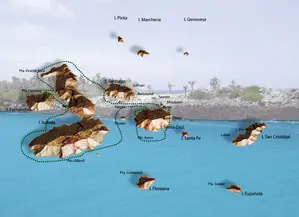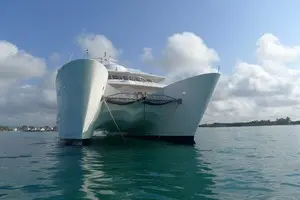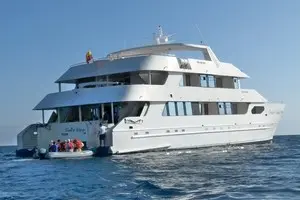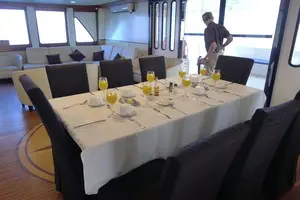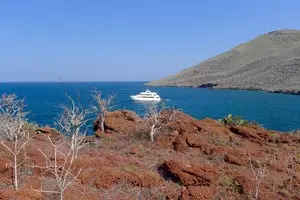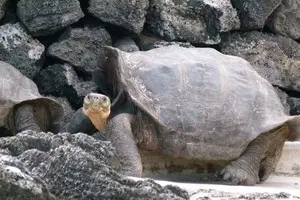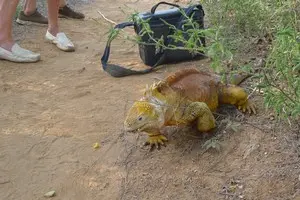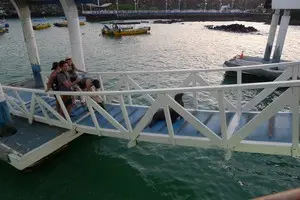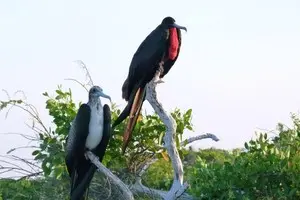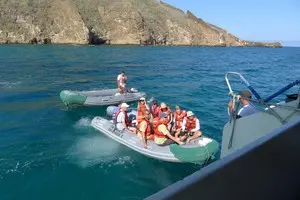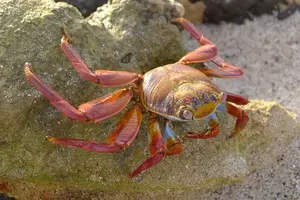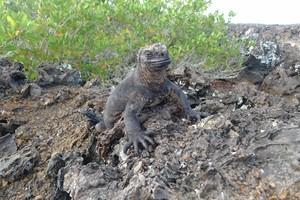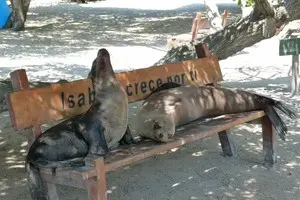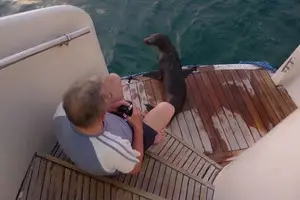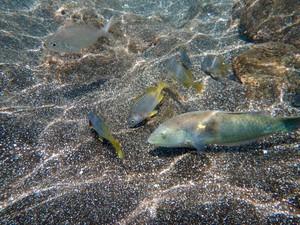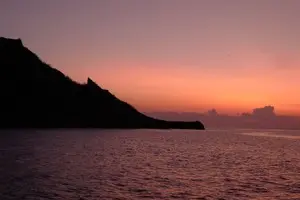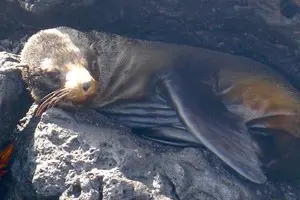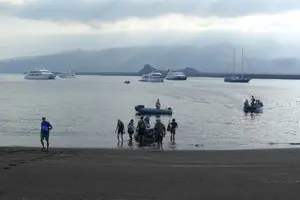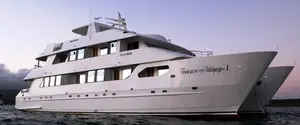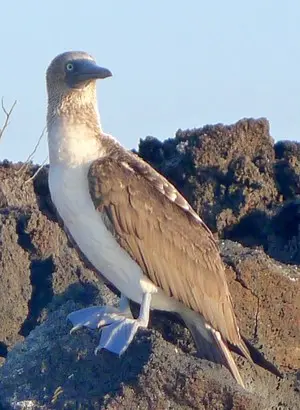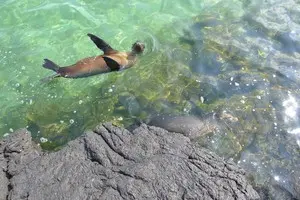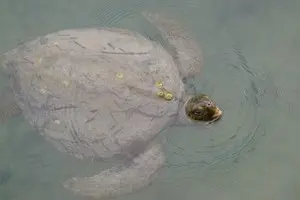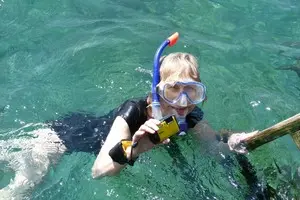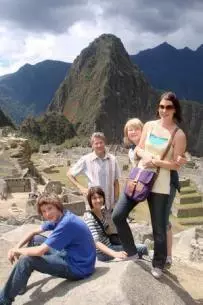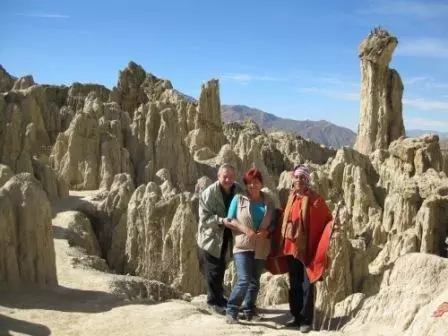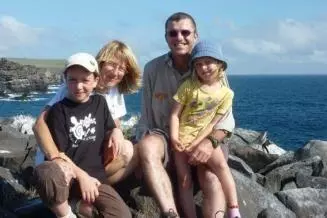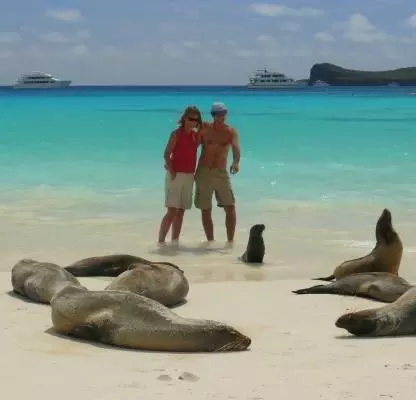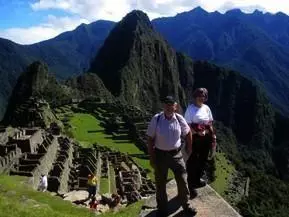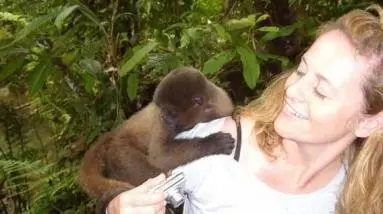Galapagos travel diary by Ms. Reinhild Berger, April 02nd - 08th, 2016
Travel diary Galapagos by Mrs. Reinhild Berger: One week on the "Treasure of Galapagos", Tour C (7 days, 6 nights)
Images and text by Reinhild Berger and Peter Ditzel. Ug tour graphic from the ship owner (please click graphic and pictures to enlarge!)
Friday, April 1st, 2016: The Dutch airline KLM starts at 6 a.m. from Stuttgart to Amsterdam. From there we start our great Galapagos adventure in the morning! Amsterdam - Quito, that's a 10.000 km flight in a time of a good eleven hours. When we arrived in Quito, the capital of Ecuador, we set the clock back by seven hours - it was only afternoon. We are driven to the Hotel Rincon de Puembo, which is near the airport. Here we can rest and acclimatise a bit before we continue early the next morning to the Galapagos Islands!
Saturday, April 2, 2016: The early morning transfer to Quito Airport works reliably. Full of expectation, we now climb into an AeroGal machine and set off for Galapagos. After just under two hours of flight time, we land on Baltra, the airport island north of Santa Cruz. Sun and blue sky greet us. We are allowed to set the clock back another hour - so the first day will be really long! After the swift passport control, we pay our $ 100 entry fee to the national park. At the exit, Harry, our German guide, is waiting for us, who will accompany us for the next few days and lead us across the islands. By bus, ferry and again by bus, after about 90 minutes we reach Puerto Ayora in the south of the island of Santa Cruz, where our small, fine cruise ship is anchored. The "Treasure of Galapagos" is a catamaran (see photos above) with nine passenger cabins for a maximum of 16 guests. We move into cabin no. 1 - and we look forward to plenty of space and a balcony on the left and right. We are 14 passengers in total: four German couples, a Swiss couple, an Australian couple and a father-son team from the USA. The sightseeing program begins in the afternoon under Harry's competent guidance. From the ship we go ashore in small rubber dinghies, the so-called pangas. We visit the Charles Darwin Research Station in Puerto Ayora. In front of the entrance we see a couple of black marine iguanas, bored, dozing in the sun. In the station itself there are enclosures with various giant tortoises and large golden yellow land iguanas.
And we meet the Darwin's finches flying around freely. Harry, biologist and Galapagos guide for over 20 years, shows us interesting plants such as manzanilla, the poison apple tree and the tree-like opuntia. We learn that all turtle eggs on all islands are collected by humans and hatched in the two scientifically supervised breeding stations. After hatching, the young turtles remain under protective care until they have sufficiently strong shells and thus a high chance of survival. Then they are brought back to their home islands and released into the wild. The turtle program in Galapagos has been crowned with success: the population is stable. On the way back we stroll a little through Puerto Ayora, the largest town in the archipelago. There are many souvenir shops, bars and restaurants with internet access, pharmacies and a supermarket. Back at the pier and on the boat jetty, we almost stumble across sea lions, who naturally lie around on the way and do not fear the proximity of the many people, and even put on a little show if they feel like it.
Sunday, April 3, 2016: The ship drove on to the west coast of Santa Cruz overnight and anchored off the island of Isla Eden, which actually has something like paradise on it. We get into the two pangas, dutifully wrap ourselves in life jackets and drive along the paradisiacal coast. The sea is turquoise and glittering. We watch a swimming sea turtle, many pelicans, blue-footed boobies, frigate birds (first picture see below), sea lions, lots of red cliff crabs and their black offspring, admire red mangroves with stilt roots hanging in the open air. Later while snorkeling we swim with colorful fish and one or two sea turtles.
In the afternoon a shore excursion: the destination is Cerro Dragon, still in the west of Santa Cruz. Red cliff crabs (see picture below) form the reception committee when we get out of the pangas. Three marine iguanas sun themselves on a small sandy beach. We balance here over lava rock with many corners and sharp edges. The path leads through a jungle past a lagoon with flamingos and red stilt birds. Then we meet the first golden-yellow land iguana in the wild: a strong male, as the color shows. But there are more to come! A land iguana crosses the path right in front of us and can be photographed in peace.
Again and again we see large holes in the ground. This is where the females lay their eggs. In the distance we discover black goats, a few are still tolerated on the Galapagos and their numbers are constantly monitored. A few decades ago, the goats released by the ship's crews, which the seafarers used as fresh meat when needed, had increased so much that the islands' vegetation had been damaged. Targeted hunting has made the situation uncritical.
Monday 4th April 2016: In the morning the ship anchors in the southeast of the island of Isabela in front of the small town of Puerto Villamil. Even before breakfast we take the rubber dinghies to Les Tintoreras, where the Galapagos penguins live. We see them sitting on the coastal rocks and swimming in the sea. After landing, we walk a small, laid-out path along the sea coast and see three large sea turtles in a water basin formed by two rocks. There are lots of red cliff crabs and the gray-black marine lizards, which are excellently camouflaged in terms of their color, with their imposing peaks on the back of their heads and backs.
The path leads through boulders of lava overgrown with light green, yellow and white lichen. We reach a small sandy bay where sea lions play. The next item on the program today is swimming and snorkeling in the bay of Puerto Villomil. Marine iguanas also swim and dive here, but also many colorful schools of fish. The sea lions loll on a bench by the roadside and take their morning nap. The mangrove forest through which we walk is impressive. Marine iguanas with impressive head and back teeth claim their place on the wooden walkways, so that pedestrians have to avoid them. In the afternoon we visit the turtle breeding station on Isabela in Puerto Villamil.
There are Galapagos turtles of all sizes and ages as well as shell variations. A very picturesque path leads from the breeding station on wooden walkways through the typical, dense island vegetation. Here, too, there are brackish water lagoons with flamingos, moorhens and other birds. The varied path leads directly to the sea. We are surprised by a deserted, wide and long, white sandy beach. There are some colorful houses on the land side. We quickly find a bar that offers WiFi - a piece of civilization in wild nature. When we want to moor at our ship with the pangas again, a small sea lion is lolling on the entry stairs. We respect our little guests, we anchor the boat on the other side.
Tuesday, April 5, 2016:From our cabin balcony we watch a lot of sea turtles swimming around our ship. The impressively large animals curiously stick their heads out of the water. A great morning mood. Our anchorage this morning is Punta Moreno on the southwest coast of Isabela. In the background, on the island, we see the Sierra Negra and Cerro Azul volcanoes. Our morning hike leads over lava rocks with bizarre patterns and shapes. We walk over pointed stones, sharp edges, sudden break-ins, large crevices and differently colored layers of rock. You have to look carefully where you step. Surprisingly, there are always small green, overgrown areas in the stone wasteland. The yellow-green lava cacti also grow out of the rocks. There are hardly any animals to be seen here, just a few lizards every now and then. At the end of the path, a family of sea lions cavort on a small rocky sandy beach. The red cliff crabs also hang on the rocks that face the sea. The pangas pick us up, we go back to the ship. The journey continues north to Urbina Bay. Here we walk on a landscaped path and meet land iguana beauties. On the beach we can snorkel and “catch” fish with the camera. There are beautiful shells lying around, unfortunately you are not allowed to take any with you.
Wednesday, April 6, 2016: We anchor in the bay of Punta Espinosa, in front of the island of Fernandina, which is the most westerly of the whole archipelago. With the pangas off we go for a country walk. Punta Espinosa is actually the realm of marine iguanas. There are hundreds here, maybe even thousands. However, the picture that presents itself to us is sad. Due to the climate and ocean currents phenomenon El Niño, the Pacific Ocean on the west coast of South America has been much too warm for months this year (25 degrees instead of the normal 15 degrees). This means that the marine iguanas, which only feed on the cold water algae carpet, can hardly find any food. To the left and right of the path are dying or already dead animals as skeletons. An image of misery and compassion. The comforting sight of two flightless cormorants, typical of the Galapagos, waving their stubby wings merrily. In the course of evolution, these birds have lost their wing strength in favor of strong chest and leg muscles, which offer them optimal swimming properties. Like in a bathtub, a couple of sea lions cavort in a rock water basin. A beautiful natural spectacle. We also see lava herons, buzzards, pelicans, lizards and the red cliff crabs, which are sparkling with all their colors. In the afternoon a wet adventure: we drive along the coast with the pangas and admire pelicans, blue-footed boobies, black swallows, lava herons, marine iguanas, take the boat to impressive rock caves that look like cathedrals. The rock layers impress with their many different colors. But then the ride suddenly becomes unusually rough! High waves make the boat rock, we ride mighty roller coaster. The water sloshes into the boat, we are all wet in quick succession. How good that Harry had advised us beforehand to protect our cameras. Our skipper steers the boat as well as possible between the crests of the waves, but cannot prevent us from being showered over and over again. Our big ship drives towards us, collects us and the two pangas. We get out soaking wet. The next highlight of the day is approaching: We cross the equator. If you like, you can stand in the captain's cockpit and watch the devices that indicate the crossing of the equator. Our barman serves a drink for everyone, a kind of light mulled wine that tastes like cinnamon. In the evening we admire the fantastic starry sky with such an incredibly white Milky Way as we have never seen it before.
Thursday April 7st: In the meantime we have bypassed the northern tip of the island of Isabela, have passed the equator a second time from the north and are now anchoring off the island of Santiago in Puerto Egas in the morning. A uniformly round volcanic cone rises in front of us. With the pangas we set off for a country walk. We walk over black sand paths and over lava rocks, which are really slippery near the water. Small marine iguanas feed on small green oases in the middle of the rock. We see Darwin's finches, Ani (the South American cuckoo relatives), mockingbirds, Galapagos pigeons, herons. At the end of the path we discover two Galapagos fur seals between rocks.
In contrast to the sea lions, they have a longer fur, a more rounded head with a massive neck and a blunt snout. The two patiently play a photo model. After the walk, you can still snorkel. The fish can also be photographed well this time. In the afternoon the islet of Rabida is our destination. The specialty here are the bright red colored rocks and sandy beaches. After the wet landing (you stand up to your knees in the water, see picture below) we walk a beautiful path up and enjoy the view of the turquoise sea and the bay, in which our white ship shines.
We see sea lions, lizards, a few birds typical of the Galapagos, for example the brown pelicans. And if you want, you can snorkel on the red sandy beach and admire turtles and colorful fish again.
Friday April 8nd: During the night the ship returned to Santa Cruz. In the morning at 6 o'clock we drive with the pangas to the beach of Las Bachas. We walk barefoot through the white sand and enjoy the morning mood. The sea turtles lay their eggs on this beach. We see the wide crawl tracks of the turtles, up the beach to the egg-laying site. We are only allowed to walk on the small strip near the water. A pair of frigate birds presents itself to us in full beauty, the male not with an inflated, but clearly visible red neck pouch or throat pouch. A pretty blue-footed booby also appears to say goodbye to us before we return to the ship, which then takes us to the airport island of Baltra.
The last time we climb the pangas - the bus is waiting for us on land. A gold-colored land iguana romps around the roadside and offers itself for a very last photo. Goodbye Galapagos! Bye, you many Galapagos animals! It was nice to see and admire you. We'll take you home with us in our photos. A big thank you to Harry for his knowledgeable and personable guide! We fly from Baltra to Guayaquil and from there again with KLM to Amsterdam in eleven hours. Now the clock is put forward eight hours - so we arrive in Stuttgart on Saturday evening safe and sound and full of deep impressions. The "Treasure of Galapagos" For me it was the first time that I spent a week on a ship. The "Treasure of Galapagos" is a comfortable catamaran, built in 2009, has space for a maximum of 16 passengers. The cabins are very spacious, each with its own bathroom and toilet. The restaurant area, the bar and the sun deck also offer plenty of space and are well equipped. An eight-person crew is responsible for the well-being on board, who - mostly in the background - tirelessly ensure comfortable and safe travel, physical well-being, order and cleanliness. The young men who steered our little pangas through the sometimes lively sea were excellent at their job. They were attentive in every moment and always gave me a feeling of one hundred percent security. The kitchen and service staff were always friendly and courteous, the dishes were lovingly prepared. When we returned to the ship from our excursions, freshly squeezed fruit juices and small snacks were always ready to greet us. The snorkeling equipment was provided free of charge, and cozy bath towels were also provided after each snorkeling session. Breakfast, lunch and dinner were served as a buffet. I always liked it and I also liked to try fruits that were unknown to me, such as the tree tomato. Coffee, tea and water were available for self-service throughout the day. You only had to pay extra for alcoholic drinks. I quickly got used to the gentle rocking of the ship and I found it wonderful. Especially at night I felt like a baby in the cradle and - despite the eight hour time difference - I slept wonderfully and restfully. Every two days we were given fresh towels that were wrapped around the bed with imaginative animals and flowers. It was pure relaxation to sit on the small cabin balcony and, above all, to look at the water while the ship was moving, to enjoy the distant view of rocky islands or even volcanoes or to watch the birds. The weather was extremely pleasant during our stay. Anyone interested in the ship can find all the information here: www.treasureofgalapagos.de
The entire organization of the trip was perfect. Thank you to "Frobeen Erlebnisreisen", www.frobeen.de
Review and outlook - my thoughts:
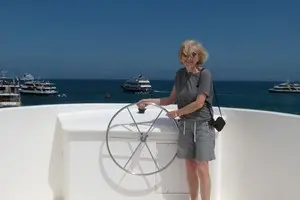
The Galapagos Islands are located 1000 km west of the South American coast in the equatorial zone. The animals and plants here - far away from the mainland - have developed idiosyncratic shapes over centuries and developed a self-contained ecosystem. Until seafarers discovered the archipelago in the 16th century and exerted influence. The ship's crews caught the giant tortoises and put them on their boats as long-lasting meat supplies. They later released goats on the islands, which reproduced and were caught by seafarers if necessary - for food purposes. With the ships and the first human colonization, dogs, cats and rats also came to the islands. The giant tortoises were almost extinct in the 20th century, the goats had eaten some regions bald, dogs killed and ate the land iguanas. Cats and rats troubled the local bird population. It was not until the middle of the 20th century that people realized the devastating effects on the islands' ecosystem and began to take systematic nature conservation measures. The turtles were consistently protected and bred. Tens of thousands of goats were killed, and wild dogs, cats and rats were fought. The original flora and fauna visibly recovered. With the establishment of the Galapagos National Park in 1959, the focus was on nature conservation and tourism was set clear. The islands have been on the UNESCO World Heritage List since 1978. But the wheel can only be turned back to a limited extent. Today there are new threats to the native animals. An introduced mosquito prefers to lay its eggs in bird nests. The larvae of this mosquito feed on the blood of newly hatched birds, so that they die. The Darwin finches are particularly affected, but the blue-footed booby population has also declined significantly in recent years, as our Galapagos guide Harry told me. The sea turtles are brutally torn to pieces by the new speed boats that are increasingly plying between the individual islands. The marine iguanas suffer from a lack of food due to the excessively warm sea temperature. We saw the mass extinction impressively and with sorrow during our stay. In general, the number of fish in the Pacific is declining, which could have consequences for fish-eating birds, but also sea lions and fur seals.
Harry also reported to us that the state of Ecuador has passed a new framework law that should allow the borders of the national park to be moved to the Galapagos. The people who live on Santa Cruz Island want to expand further. And they want to do business with tourists. Finding the right balance here will be a task for the future. May nature find enough advocates and active protectors - this is my biggest wish. So that later generations can still enjoy this very special natural paradise on our earth! What particularly fascinated me: The wonderfully turquoise, clear sea. The bizarre formations of the lava rock and the view of the conical volcanoes. The sunrises and sunsets. The incredible starry sky at night! The different kinds of sandy beaches: there were white, wide dream beaches, but also beaches with black and deep red sand. The underwater world with the colorful, glittering fish and schools of fish.
The local bird world with its special "types": The funny blue-footed boobies, which shoot vertically with their beak down into the water to catch fish and which actually have beautiful blue feet. The flightless cormorants with stubby wings, the frigate birds with their red throat sacs, the lively little Galapagos penguins. The “dragon world” is also unique: the lava stone-colored marine iguanas that fight so bravely against the famine, the golden shimmering land iguanas.
I would have liked to have seen the giant tortoises in the wild - unfortunately we weren't lucky. The sea turtles that are still abundant have made up for this - may they learn to dodge the people's speedboats!
Reinhild Berger, April 2016


